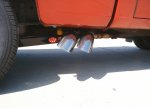Well, I’m only 2 years younger, and that’s nothing I ever heard of. There is zero benefit to running more octane than you need, so I run the least octane that will work. If it really is carbon build up in the combustion chambers (speculation at this point), on a modern engine with feedback fuel injection that usually the result of something else that’s been malfunctioning for a while. 166k isn’t that extreme, and it sounds like yours has done this for a long time, so you might consider it’s from something else, like the mods on the efi system.
From Exxon but really they just want your money so take it for what it is, a brand's spin on it.
https://www.exxon.com/en/octane-rating
Octane ratings
Understanding octane ratings
About octane ratings
Octane rating is a measure of a fuel's ability to resist ‘knock.’ The octane requirement of an engine varies with compression ratio, geometrical and mechanical considerations, and operating conditions. The higher the octane number, the greater the fuel’s resistance to knocking or pinging during combustion.
The octane ratings of Synergy™ gasoline
- Synergy™ Regular Gasoline – Octane 87
- Synergy™ Extra Gasoline – Octane 89
- Synergy SUPREME+™ Gasoline – Octane 91-93
========================================
This is from the U.S. Energy Information Administration And the one to read as the information is is much more in depth (EDIT: also was updated December 5th 2019 at teh time of this posting):
https://www.eia.gov/energyexplained/gasoline/octane-in-depth.php
What is octane?
In recent years,
car manufacturers have been requiring or recommending premium gasoline (a high-octane grade of fuel) for use in more of their vehicle models. The
difference in prices between premium and lower octane grades has also increased. As a result, more people are curious about what octane is and what those octane rating numbers on gas pumps mean.
Octane ratings are measures of fuel stability. These ratings are based on the pressure at which a fuel will spontaneously combust (auto-ignite) in a testing engine. The octane number is actually the simple average of two different octane rating methods—
motor octane rating (MOR) and
research octane rating (RON)—that differ primarily in the specifics of the operating conditions. The higher an octane number, the more stable the fuel. Retail gasoline stations in the United States sell three main grades of gasoline based on the octane level:
- Regular (the lowest octane fuel–generally 87)
- Midgrade (the middle range octane fuel–generally 89–90)
- Premium (the highest octane fuel–generally 91–94)
Some companies have different names for these grades of gasoline, such as unleaded, super, or super premium, but they all refer to the octane rating.














